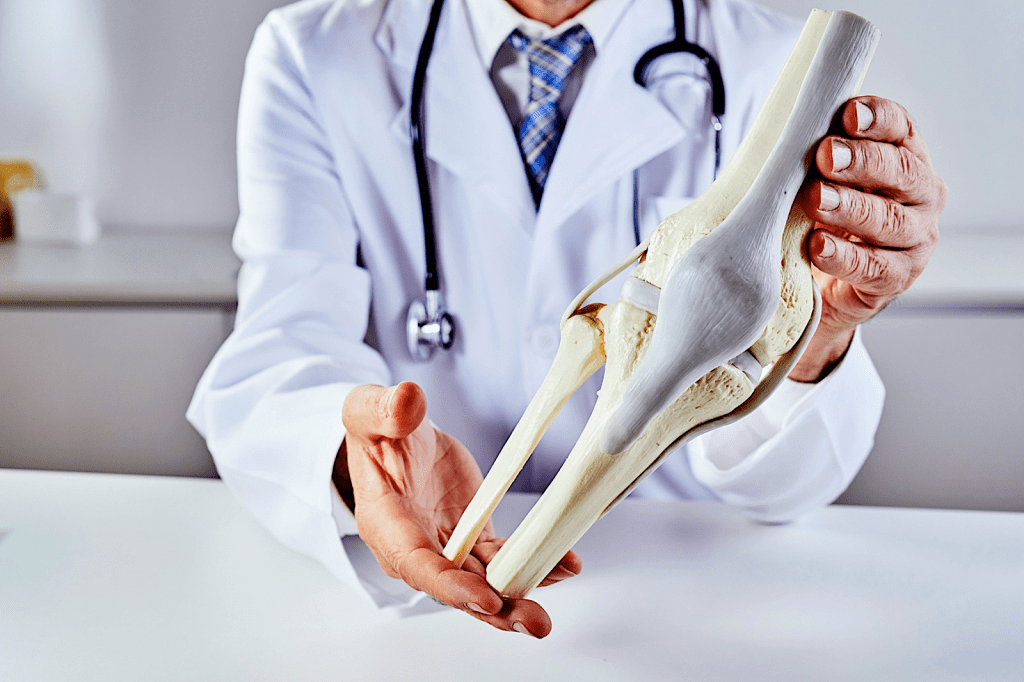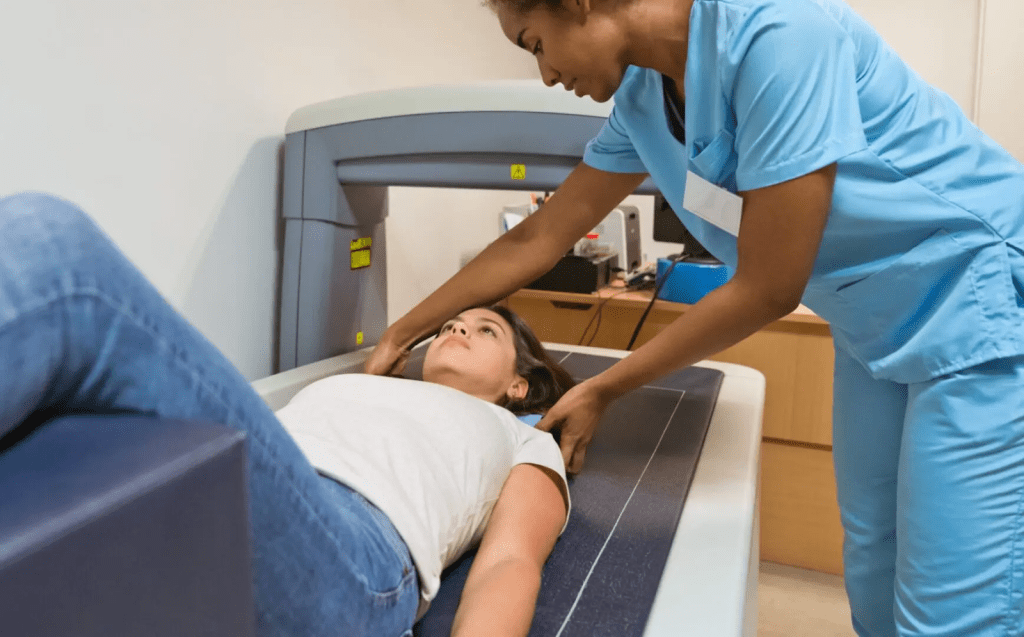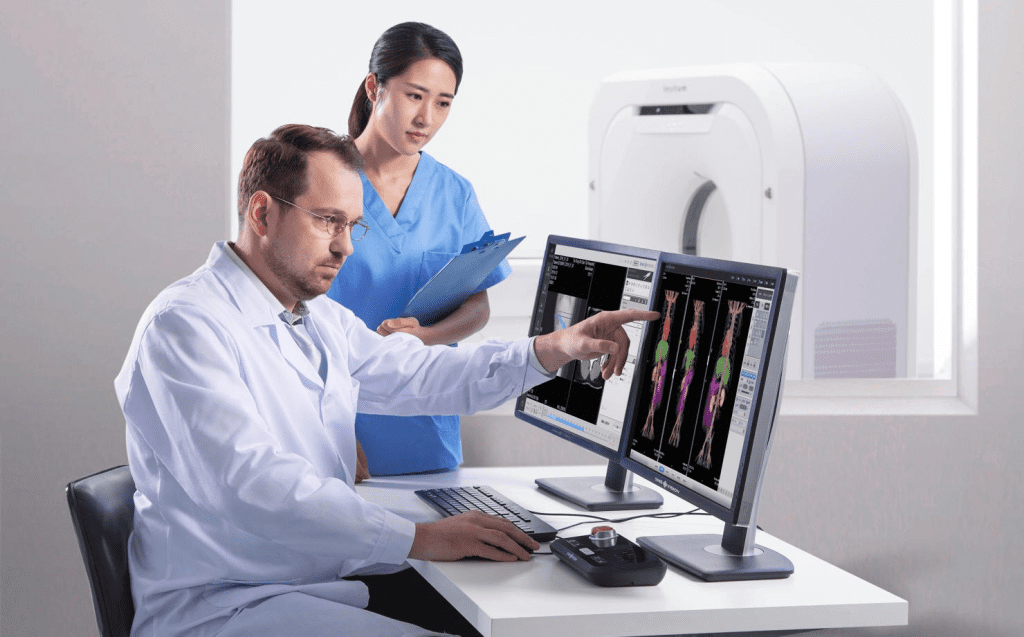Last Updated on October 22, 2025 by mcelik

Nearly 1 in 2 people will face a bone-related issue at some point. This makes tools like bone scans very important for treatment.
A bone scan is a type of nuclear medicine imaging. The bone scan purpose is to check the skeletal system for problems such as cancer, infections, and fractures.
Doctors use bone scans to see how much damage or disease is in the bones. This helps them pick the best medical imaging techniques for diagnosis.

Bone scans are key in nuclear medicine, giving us a peek into bone health. They help us see how bones work and spot problems.
Nuclear medicine is key in bone imaging. It uses radioactive tracers to show where bones are active. This tech is vital for understanding bone scans.
A bone scan, or skeletal scintigraphy, is a test that injects a tiny bit of radioactive material. This material goes to the bones, letting a camera take pictures of the skeleton.
The test works because sick or injured bones take up more of the radioactive material. This makes bone scans great for finding skeletal issues.
Radioactive tracers are the heart of nuclear medicine’s bone diagnosis. These tracers send out gamma rays, which a camera catches to make bone images.
The top tracer for bone scans is Technetium-99m methylene diphosphonate (Tc-99m MDP). It sticks to bones that are growing or breaking down, perfect for spotting bone problems.
Bone scans are different from X-rays, CT scans, and MRI scans. While those tests show what bones look like, bone scans tell us about bone activity.
This special ability makes bone scans great for finding things like bone tumors, fractures, and infections. They can spot these issues before other scans can.
In short, bone scans are a powerful tool in nuclear medicine. They give us important info on bone health. Their skill in finding many bone problems makes them a key part of medical diagnosis today.

Bone scans are key in diagnosing and managing bone disorders. They offer insights that other imaging methods might not catch.
Bone scans are used in many important medical situations. They help find cancer that has spread to bones, diagnose bone pain without a clear cause, and spot stress fractures or injuries not seen on X-rays.
They are also key in checking how far bone diseases like Paget’s disease have spread. They help see how well treatments for bone metastases are working. Bone scans are a vital tool in medical care.
Bone scans can image the whole skeleton. This makes them great for finding disease in many places at once.
Unlike X-rays or CT scans, which focus on specific areas, bone scans show the whole skeleton. This is very helpful for finding diseases like metastatic bone disease, which can affect many areas.
Comparison of Diagnostic Imaging Techniques
| Imaging Technique | Primary Use | Advantages |
| Bone Scan | Whole-body bone assessment | Detects multiple areas of disease, useful for metastatic disease |
| X-ray | Localized bone assessment | Quick, widely available, good for initial assessment |
| CT Scan | Detailed cross-sectional imaging | Provides detailed images of bone and soft tissue |
The table shows how bone scans are better than other imaging methods. It points out their importance in checking the whole skeleton.
Bone scans are key in finding and managing bone cancer. They show if tumors are present and how far they’ve spread.
Primary bone cancers are rare but can grow fast. A bone cancer scan is vital for early diagnosis. It shows how big the tumor is and helps decide treatment.
To do this, a tiny amount of radioactive tracer is injected into the blood. It goes to areas with lots of bone activity, like tumors. The scan then finds this activity, giving clear images of the bones and any problems.
“Bone scans are great for finding primary bone cancers. They show how much bone is involved and help stage the cancer.”
Metastatic bone diseases are more common than primary bone cancers. They happen when cancer from other parts of the body spreads to the bones. A diagnostic bone scan is key in spotting these metastases.
Metastatic bone disease can lead to a lot of pain and fractures. Finding it early with bone scans helps treat it sooner, improving patient results.
| Cancer Type | Frequency of Bone Metastasis | Common Sites |
| Breast Cancer | High | Spine, Ribs, Pelvis |
| Prostate Cancer | High | Pelvis, Spine, Ribs |
| Lung Cancer | Moderate | Ribs, Spine, Femur |
Bone abnormality scans are also important for checking how well treatment is working. They watch for changes in bone activity over time. This helps doctors see if the treatment is effective.
This info is key for deciding if treatment should keep going, change, or stop. It also helps manage patient hopes and improve their life quality.
In summary, bone scans are a powerful tool against bone cancer. They help find primary tumors, check for metastatic disease, and track treatment success. Their detailed insights into bone health make them essential in modern cancer care.
Bone scans are key in finding the cause of unexplained bone pain. They give insights that other tests might not. When bone pain has no clear reason, doctors use bone scans to find the problem.
Bone scans can spot problems that X-rays can’t. This is great for finding pain sources that are hard to see.
For instance, in complex regional pain syndrome, bone scans show changes in bone that X-rays can’t. This info is key for treatment.
Bone pain can come from many things like fractures, infections, and tumors. Bone scans help doctors tell these apart by showing where bone activity is off.
| Cause of Bone Pain | Characteristics on Bone Scan |
| Fractures | Increased uptake at the fracture site |
| Infections | Diffuse uptake in the affected area |
| Tumors | Focal uptake in the tumor |
By looking at bone activity, doctors can figure out what’s causing pain. Then, they can plan a specific treatment.
Bone scans are key in sports injuries and care for older adults. They help find stress fractures and hidden fractures. These fractures are hard to spot with regular imaging.
Athletes, mainly those in high-impact sports, often get stress fractures. These are tiny cracks in bones from repeated stress or force. Bone scans are very good at finding these fractures before they show up on X-rays. Finding them early helps prevent more damage and lets athletes safely get back to their sports.
To do this, a tiny amount of radioactive tracer is injected into the blood. It goes to areas of high bone activity, like stress fractures. The scan then shows these areas, making fractures visible that might not be seen other ways.
Bone scans also help a lot with older adults. They find fractures that aren’t seen on regular X-rays. This is because older people often have osteoporosis and changes in bone density. Bone scans can spot these fractures, helping doctors understand and treat the patient better.
Being able to find these fractures is very helpful for older patients. They might not show clear symptoms or can’t get detailed checks. Accurate diagnosis lets doctors give better care, improving patient results.
Bone scans are key in finding and managing bone infections. These infections, like osteomyelitis, can be serious if not treated quickly. They can come from bacteria or fungi spreading to bones through the blood or nearby tissues.
Early detection is key to manage bone infections well. Bone scans use a small radioactive tracer that shows up in infected areas. This makes them great for spotting osteomyelitis, which causes pain, swelling, and fever.
Osteomyelitis is a serious bone infection that needs quick diagnosis and treatment. Bone scans are very good at finding osteomyelitis early. Spotting it early helps avoid long-term damage and complications.
After finding a bone infection, it’s important to check how it’s responding to treatment. Bone scans can be done again to see how well the treatment is working. This helps doctors adjust treatment plans as needed.
“Bone scans provide a valuable tool not only for diagnosing bone infections but also for monitoring their response to treatment, allowing for more personalized and effective care.” – Expert in Nuclear Medicine.
Using bone scans helps doctors improve care for patients with bone infections. The detailed images from bone scans help doctors diagnose and monitor infections accurately. This leads to better care for patients.
Bone scans are key in managing arthritis and inflammatory joint diseases. They help doctors see how the disease is progressing. This information is vital for choosing the right treatment.
Bone scans are great for telling different types of arthritis apart. They show how much and where the joints are affected. This helps doctors understand the disease better.
For example, rheumatoid arthritis shows up in both sides of the body. Osteoarthritis, on the other hand, affects specific areas more. Knowing this helps doctors create better treatment plans.
Early and accurate diagnosis is very important. It helps treatments work better and can slow down the disease. This improves how patients feel and function.
Bone scans also help track how active the disease is and how it’s changing. They show if treatments are working. This is important for managing long-term conditions.
They can also spot problems like bone damage or deformities early. This allows for quick action. The insights from bone scans help doctors give more focused care.
Bone scans are key in tracking how bones heal after a fracture or surgery. They give doctors important details about the healing process. This helps them make better choices for their patients.
Bone scans are great for checking on bone healing. They use special tracers that show where bones are most active. This helps doctors see if bones are healing right or if there are problems.
Bone scans are a good way to watch how bones heal. They let us act fast if bones aren’t healing as they should.
Knowing how bones heal is very important. It helps doctors find out if a patient needs more help or a different treatment. It also lets them tell patients who are healing well, which makes patients feel better and more confident.
After surgery, bone scans can spot problems like infections or loose implants. These issues can be hard to find with regular X-rays. A study in a Journal found, “Bone scans are very good at finding problems after surgery, helping us act quickly.”
Finding problems early is key to fixing them. Bone scans help doctors:
By using bone scans, doctors can give more focused care. This makes patients do better and lowers the chance of long-term problems.
Bone scans are key for spotting and handling metabolic bone disorders, like Paget’s disease. These issues harm bone health and can cause problems if not caught and treated right.
Paget’s disease is a long-term bone problem that makes bones grow too big and deformed. A paget’s disease scan spots the bone changes seen in this condition.
Nuclear bone scan tech helps find Paget’s disease early. This means doctors can act fast.
Besides Paget’s, bone scans help find other metabolic bone disorders. These include:
A metabolic bone scan shows how much bone is affected. It helps doctors know how serious the problem is. This info is key for making a good treatment plan.
Bone disorder imaging through bone scans gives deep insights into bone activity. It helps diagnose and manage many metabolic bone diseases.
Knowing what to expect from a bone scan can greatly improve your experience. A bone scan is a test that finds bone problems like cancer, infections, and fractures. It’s a key tool for doctors.
Getting ready for a bone scan is easy. You’ll need to:
Wear comfy clothes and avoid certain foods and drinks. But, your doctor might give you specific rules.
The bone scan process has a few steps:
After the scan, you can go back to your usual activities. The tracer leaves your body in a few days. You’ll get your results in a few days to a week.
Make sure to talk to your doctor about the results and what comes next.
In summary, while a bone scan might seem scary, knowing what to expect makes it easier. Understanding the steps and what happens after can really help.
Bone scans are a key tool in diagnosing health issues. Yet, it’s important to know the risks and limitations. Safety is a top priority to protect patients and make sure the scan works well.
Bone scans use radioactive tracers, which emit radiation. The amount of radiation is usually safe. But, it’s vital to follow strict safety rules to keep exposure low. Patients should tell their healthcare provider about any past nuclear medicine scans or radiation exposure to avoid too much radiation.
Medical facilities follow strict guidelines for handling radioactive materials. They ensure the right amount is used and that equipment is in good working order.
Some people face higher risks with bone scans. Pregnant or breastfeeding women are usually advised against them because of the risks to the fetus or baby. Those with allergies to the tracer’s components should also let their healthcare provider know.
Patients with severe kidney disease need extra care. Some tracers are removed by the kidneys. Healthcare providers carefully check each patient’s health to find the safest option.
Knowing these risks and taking the right steps helps healthcare providers. This way, bone scans can be done safely and effectively.
The future of diagnosing bone health is bright, thanks to new imaging technologies. These advancements promise better precision and detail. Medical tech keeps getting better, leading to new ways to diagnose and treat bone issues.
Single Photon Emission Computed Tomography (SPECT) is a way to see the body’s metabolic activity in 3D. When paired with CT scans, it gives both functional and anatomical views. This combo boosts accuracy for complex bone problems.
SPECT/CT fusion imaging shines in showing bone metabolism and spotting abnormal activity. It’s great for finding cancer in bones, infections, and some arthritis types.
Positron Emission Tomography (PET) scans are used for bone checks. They use radioactive tracers that light up where the body is most active, like growing bones or tumors. This makes PET scans top-notch for spotting bone cancer, tracking treatment success, and diagnosing metabolic bone diseases.
Using hybrid imaging techniques like PET/CT and PET/MRI takes it up a notch. They mix PET’s functional data with CT or MRI’s detailed anatomy. This combo helps pinpoint and understand bone lesions better.
As these advanced imaging tools get better, they’ll be key in diagnosing and treating bone issues. The future might bring even more advanced PET tracers and SPECT tech.
Bone scans are key in today’s medical world. They help doctors find and treat bone problems. These scans are used to check the health of the skeletal system.
They use special imaging to see inside the bones. This helps find diseases like cancer, infections, and bone disorders. Bone scans use radioactive tracers to spot problems that other tests can’t see.
Bone scans give a detailed look at the bones. This helps doctors catch and treat bone issues early. It makes a big difference in how well patients do.
In short, bone scans are essential for diagnosing diseases today. They show how important it is to keep improving medical imaging. This helps doctors take better care of their patients.
A bone scan is a test that uses nuclear medicine. It helps find and track bone problems like cancer, infections, and fractures.
A bone scan is different from X-rays or CT scans. It uses radioactive tracers to see how bones work. This helps find problems in bone activity.
Doctors often order bone scans for several reasons. They help diagnose and track conditions like bone cancer, infections, and fractures.
Bone scans help find bone cancers and track how well treatments work. They look at changes in bone activity.
Yes, bone scans are great at finding stress and hidden fractures. They are very useful for athletes and older people.
Bone scans help spot bone infections early. They also track how well treatments are working by looking at bone activity.
Bone scans help figure out what kind of arthritis someone has. They also track how the disease is progressing.
Bone scans check how well bones are healing after a fracture or surgery. They help spot any problems.
Bone scans use a small amount of radiation. They are not safe for pregnant women or certain other groups.
SPECT and PET scans give more detailed info about bone activity. This helps doctors make more accurate diagnoses and track conditions better.
During a bone scan, a tiny amount of radioactive tracer is injected. Then, images are taken with a gamma camera after a wait.
Before a bone scan, you might need to remove jewelry and wear loose clothes. You might also need to avoid certain foods or meds.
Getting bone scan results can take a few hours or days. A radiologist will look at the images and send a report to your doctor.
Subscribe to our e-newsletter to stay informed about the latest innovations in the world of health and exclusive offers!